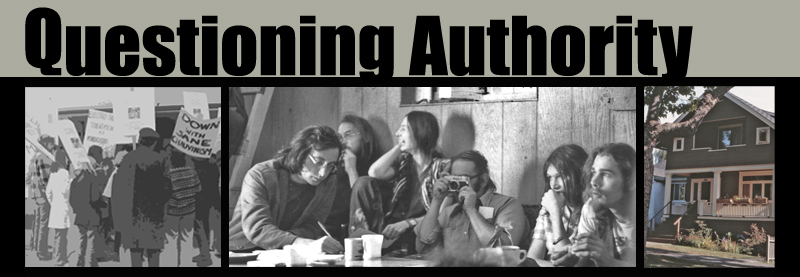More for the Mind: Home > Questioning Authority Home > Questioning Authority: Lesson 1
Lesson One: Activism
Approximately one hour
 Opener: Introduction (5-10 minutes)
Opener: Introduction (5-10 minutes)
- Ask students to name groups that have banded together to demand change or that their rights be recognized in the sixties or seventies.
- List them on the board or overhead. Possible answers include: environmental groups such as Greenpeace, women’s liberation groups, First Nations, Gays and Lesbians, and various ethnic groups.
- Explain to students that another group that became active during the time period that dealt with the rights of people in the mental health system.
 Activity 1: “Psych Survivor Activism Video” (15-20 minutes)
Activity 1: “Psych Survivor Activism Video” (15-20 minutes)
- Inform the learners that they will be watching interviews of activists in the anti-psychiatric movement. Ask them to identify issues and to find examples of stigma
- Ask students to infer why and how each person became an activist
- Show “Psych Survivor Activism- History of Madness” (2010, approximately 15 minutes)
 Discussion: Reaction to the Video (10-15 minutes)
Discussion: Reaction to the Video (10-15 minutes)
- After the video ask students:
- for examples of discrimination and stigma. Record answers on chart paper and keep until final lesson.
- what made people move beyond seeing their mental health difficulties as more than just a personal story?
- how is this activism the same and what makes it different from other movements (based on students prior knowledge)?
- explore Pat Capponi’s statement about the necessity for leaders to go first
- discuss the snowball effect (exponential growth after momentum begins)
- what was the point of the ex-patient movement? What goals did these activists have?
- Discuss the importance and power of language (see Background Information for Teachers), for example the reclaiming of ‘mad,’ the use of words such as ‘incarcerated’.
 Activity 2: Interpreting Cartoons – Power in Numbers (20 -25 minutes)
Activity 2: Interpreting Cartoons – Power in Numbers (20 -25 minutes)
- Show students a cartoon from Phoenix Rising “The Movement” (PR_The_Movement_Cartoon). Together, look at the elements of the cartoon to interpret it fully. For example, the variety of people depicted= many people’s lives are affected by psychiatric consumption and survival, or the phoenix as a symbol of rebirth and new beginnings
- Divide students into three groups and provide each group with a blown up version of cartoons that appeared in Phoenix Rising (Rights 1, graphic, Phoenix Rising, 1983, 3, 4.; Rights 2, graphic, Phoenix Rising, 1983, 3, 4.; Rights 3, graphic, Phoenix Rising, 1983, 3, 4.)
- Give each group time to interpret the cartoon and then present it to the class
- Conclude by discussing how change can be effected when people work together. Ask, how do people become politicized?
 Closing: The Problems Activists Faced (5- 10 minutes)
Closing: The Problems Activists Faced (5- 10 minutes)
- Ask students to identify problems that (ex-)patient activists might have faced.
- Look for answers that reflect an understanding that the stigma patients faced hampered their efforts.
- Insightful students will also realize that the lack of an easily identifiable group (as compared to women or ethnic minorities) might also affect group development.
 Reaching All Learners
Reaching All Learners
- This activity should be accessible to most learners.
- Some students may benefit from whole class interpretation of the cartoons, allowing teacher direction in inferring from the cartoons.
 Resources for Lesson One, Activism
Resources for Lesson One, Activism
Activity 1
- Psych Survivor Activism- History of Madness
Activity 2
